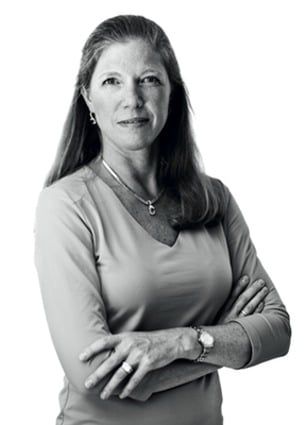
Photograph by Stephen Voss
The morning of her surgery, around 5 AM, Christy Teal put on some mascara. Without makeup, she says, her blond eyelashes make her look like a little girl. And she’s always liked it when her patients come into the operating room wearing lipstick. You look good, you feel good.
When a nurse walking her from the registration desk to the pre-op area calls her Dr. Teal, she quickly corrects the woman: “It’s Christy. I’m the patient today, not the doctor.”
Teal, 44, chief of breast surgery at George Washington University Hospital, is here to undergo a prophylactic double mastectomy. She doesn’t have cancer or the genetic abnormalities known to increase risk. She has never had a cancer scare. She’s here because her mother, Nancy, was recently diagnosed with an aggressive form of breast cancer and she’s worried she’s going to get it, too. She’s here because she has a seven-year-old daughter and five-year-old twins and she doesn’t want breast cancer to get in the way of watching them grow up.
She’s not as nervous about this surgery as she was for her mom’s, Teal says. She had pork tenderloin for dinner last night and enjoyed a glass of wine. She read to her little boy, Nick. She prayed for God to guide the hands of her colleagues as they operate on her. Earlier that day, she’d seen a patient in her twenties with breast cancer, a young woman whose mother she had treated years earlier. She has no doubt she’s doing the right thing.
“Have you had anything to eat or drink?” a nurse asks as Teal lies in a hospital bed. Her instructions were to fast after midnight.
“All I had was a pancake this morning,” Teal jokes.
Colleagues stop by to give her hugs and wish her well. A surgical resident is wearing a string of faux pearls she got as a gift from Teal’s kids. Teal always wears necklaces, but not today. The resident tells her, “I figured someone should have on pearls in your OR.”
A nurse takes Teal’s blood pressure and starts an IV. “I kept thinking I’d wake up and this would all be a joke, like last summer never happened,” Teal says. Tears fill her eyes. It was two days after the Race for the Cure in June 2010 that her mother called from Pennsylvania to say she felt something under her armpit. A week later, Teal was looking at an MRI scan of her mother’s breast. Then she made the decision about her own body that even a few of her colleagues couldn’t believe.
Teal’s mother, Nancy Brown, told her when she was in seventh grade that she should think about becoming a doctor like her grandfather. When Teal was pregnant with twins and didn’t think she’d be able to handle it, her mother kept her spirits up. She taught her the value of patience, how to cook, how to do ten things at once.
Her mother, a former home-economics teacher, had early-stage breast cancer in 1997, which was treated with radiation. Doctors put Nancy on a drug called tamoxifen, which helps prevent recurrences and new cancers by interfering with the activity of estrogen, and she stayed on that for five years.
Teal and her mother talked at the 2010 Race for the Cure about how lucky Nancy was and how she’d dodged a bullet. One in eight women develops breast cancer, and Teal considered her mother’s cancer to be one of the easy ones. Nancy had been cancer-free for 13 years. When she called about the lump, her daughter told herself it was going to be nothing.
In ten years as a breast surgeon, Teal had seen plenty of benign lumps. About 80 percent of these lumps don’t turn out to be cancerous. This one was on her mother’s right side; the first cancer had been on the left. Chances were slim that her mother had developed a new primary cancer in the other breast.
The radiologist looking at Nancy’s MRI at GW the following week didn’t have to tell Teal how bad her mother’s cancer was; Teal walked into the radiology reading room, looked at the films, and saw for herself. The tumor appeared to be four centimeters. Her 74-year-old mother had Stage III breast cancer, an invasive type that had spread to the lymph nodes. Stage IV, cancer that has spread to other organs or distant lymph nodes, is the worst.
This cancer was different from the first one. That was smaller and was picked up on a mammogram; this one didn’t show up on a mammogram or an ultrasound, only on an MRI. The first cancer didn’t involve lymph nodes—the more lymph nodes affected, the more serious the disease—as this one did.
Teal was surprised that her mother’s second cancer was so advanced yet so hard to detect. She trusted mammograms and saw them catch cancers every day, but if they didn’t work for her mother, she wondered if they’d work for her. She’d treated thousands of patients and rarely saw cancers behave like this—in her mind, this cancer was acting like the kind that ran in families.
Minutes after seeing her mother’s test results, Teal walked back to her office in GW’s Medical Faculty Associates building on Pennsylvania Avenue to talk to a colleague, Dr. Anita McSwain. She’d hired McSwain, a former Air Force trauma surgeon in Iraq, two years earlier as an assistant professor of surgery. She was about to say something she knew might sound extreme.
“I want you to do my mom’s mastectomies,” Teal said. “Then I want you to do mine.”
Next: Life before breast cancer was on her radar

When Teal was 11, her older sister, Marci, accidentally got her hand stuck under a lawn tractor while their parents were out. Marci came running into the house screaming—she’d cut three fingers down to the bone—and Teal tried to calm her down and used Kleenex to try to stop the bleeding. A few years later, when their mother accidentally ran over the family dog in the driveway, it was Teal who got on the phone with the vet because everyone else was too upset.
Teal knew in high school she wanted to be a surgeon. She was good at math and science and enjoyed doing things with her hands, such as drawing and cross-stitching. Her parents asked a family friend, the head of surgery at a hospital in her hometown of Wilkes-Barre, to take her on rounds with him. Teal watched the doctor care for a burn patient and perform leg bypass surgery. She thought it was amazing the way he could go inside people’s bodies and fix things.
In medical school at Cornell, she planned to become a general surgeon, doing everything from repairing hernias to removing gall bladders. Breast cancer wasn’t on her radar. As a resident, she did a surgical-oncology rotation at Sloan-Kettering Cancer Center in New York and took care of many young women with advanced stages of the disease. She was in her late twenties, and so were they.
I could never, ever do this, she thought.
Soon after Teal moved to Washington in 1997 for a job as an attending physician at Andrews Air Force Base, her mother received her first diagnosis. A month later, Teal’s best friend, Laurie Turney, found out she had breast cancer at age 34.
When Teal and Turney had met, Teal was just out of medical school and a first-year resident at New York-Presbyterian Hospital, where Turney was a nurse on the cardiothoracic intensive-care unit. Teal was talking with a patient, and Turney saw her hold the woman’s hand, something she’d never seen a doctor do. Turney started sharing her meals with Teal—who was so skinny that the weight of her pager pulled her scrub pants down—and soon they were meeting to roller-blade in Central Park.
After four years at Andrews, Teal called the breast-care center at George Washington University and said she was looking for a job. She wanted to help women such as her mother and Turney. With general surgery, she’d realized, she might operate on someone and never see that person again. If she worked with cancer patients, she’d get to follow them for life.
Teal’s decision to have prophylactic surgery to remove both breasts—with reconstruction—didn’t involve any statistics. It wasn’t based on research or something she’d read in a medical journal. With patients, Teal practiced evidence-based medicine, relying on data and percentages. This time she wasn’t acting as a doctor: She was a daughter and a mother, and she was scared.
She usually wasn’t a worrier. She ate well and jogged every day near her home in Alexandria, but she didn’t obsess about her health. She’d missed a mammogram one year because it slipped her mind, and sometimes she forgot to go in for a Pap smear. But this was a fear she couldn’t ignore.
She knew there were options other than a double mastectomy. She sees 20 patients a day in the breast-care center, and many have a stronger family history of cancer than she does. Her high-risk patients are watched extra closely: They get MRIs or breast-specific gamma imaging (BSGI) six months after their annual mammograms, along with clinical exams twice a year. BSGI is a newer technology that detects the metabolic activity of breast tumors and has fewer false positives than MRIs; GW is the only breast center in the Washington area offering them. Unless a woman tests positive for a genetic abnormality, which Teal did not, they usually don’t have their breasts removed.
But this wasn’t about her patients, Teal says. This was about a feeling in her gut, one that told her the cancer she was going to get would be as ugly as her mother’s, the kind that could fail to show up on a mammogram and still involve 13 lymph nodes. Some people could live with that risk; she couldn’t. She didn’t like it when she wasn’t in control, such as when her twins arrived six weeks early and had to spend a month in neonatal intensive care. If she ever did get breast cancer—even ductal carcinoma in situ (DCIS), a noninvasive cancer in the lining of the milk ducts—she was confident she’d have a double mastectomy. This way, she got to decide when it happened. Breast cancer wouldn’t dictate her life.
I can do this intense screening and hope to find cancer early, she thought, or I can have surgery and avoid it altogether. She scheduled her surgery for January, giving herself six months to change her mind.
A double mastectomy wouldn’t eliminate her chances of getting breast cancer: The procedure reduces one’s risk by 90 to 95 percent, but patients can still develop cancer after surgery because a small amount of tissue remains. She was electing to have a nipple-sparing procedure, which meant her risk would be slightly higher because there would be more skin and tissue left in place. But she was okay with those odds; they wouldn’t keep her up at night. She wouldn’t need any more mammograms, just an MRI every three years to make sure her silicone implant wasn’t leaking.
It wasn’t just the cancer Teal feared but the scares. She watched patients go through them all the time: A mammogram or MRI shows something suspicious that requires a biopsy. It might be cancer; it might not. For days, they imagine the worst. She knew the wait was torture, which is why she checked for lab results on weekends, hoping to be able to call a patient with good news. She didn’t want to be the person waiting by the phone.
Next: Living in denial
A t first, Teal tried to tell herself that her mother wasn’t all that sick, that somehow the tests were wrong. She’d done the same thing the first time her friend Laurie Turney had cancer: Turney described to her what the doctor had seen on her ultrasound.
“You’ll be fine,” Teal told her. Another 24 hours of denial was a beautiful thing.
It seemed too hard to get her daughter Ashley and twins Nick and Ellie ready for school, see patients all day, and acknowledge that her mother had metastatic breast cancer. To deal with her mother’s crisis, she turned her emotions off, which was what she had to do as a doctor as well. Most of her patients had good outcomes, but she occasionally had to tell a woman who’d hoped to hear her cancer was gone that it had spread. She had a patient at Andrews who was diagnosed just after having a baby. She’d gotten to know the young mother well, and when chemotherapy wasn’t working, the woman told Teal she wanted to stop treatment and take her kids on a cruise.
What a brave thing to do, Teal thought. The woman sent Teal a photo of her family at Disney World. A few weeks later, Teal went to her funeral.
It’s not that she doesn’t cry for her patients, Teal says, or for her mother; it’s that she does it at night after she puts her kids to bed.
The day of her mother’s surgery last June, Teal scheduled cases in the operating room. The first time Nancy had cancer, she’d chosen to conserve her breasts, as many women do. This time, she needed a mastectomy on one side and chose to remove both.
“Get them off,” she told McSwain. “I just want them off.”
Teal couldn’t sit in the waiting room all day with her father. She had to keep busy. A few hours into the surgery, she checked in with her dad and asked how he was doing. He was usually a stoic guy.
“I’m sad,” he said.
Teal came out of surgery around the same time McSwain finished operating on her mother, and they ran into each other in the hallway.
“How did her nodes feel?” Teal asked.
McSwain hesitated but knew she had to say something: “I did find some enlarged, firm nodes.” Hardened lymph nodes are a bad sign.
Teal felt some relief that at least her mother’s cancer was out now. She begged the pathologist analyzing the tissue samples to please find a few nodes that weren’t cancerous.
In 2005, when her obstetrician saw two heartbeats on her sonogram, Teal burst out crying. She’d had trouble getting pregnant the first time, so she and her husband, Dave, had gone through in vitro fertilization this time. He’d been happy with one baby, but she’d convinced him to have another. She hadn’t considered the possibility of twins and didn’t feel she was ready to be a mother of three. She put in long hours at the hospital, and Dave traveled a lot for his job at Andrews Air Force Base.
Dave reassured his wife that everything would be okay with three kids. She could always rely on him. Still, she didn’t know how he’d react to her decision five years later to have elective breast surgery. Her breasts had never mattered much to her—she’d always been small-breasted and hadn’t tried to bring attention to them. They weren’t a part of her identity, but she wasn’t sure how much they mattered to him.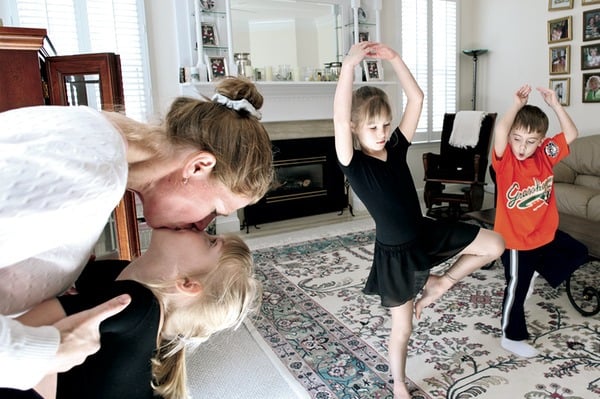
Teal didn’t want cancer to get in the way of watching her children—Ashley (center) and twins Ellie and Nick—grow up. Ashley (below right) understood that her mother was choosing to have surgery “so what happened to Grandma doesn’t happen to you.” Photograph by Chris Gavin Jones
She’d met Dave on a blind date at the Officers Club at Andrews Air Force base in January 1998, and he proposed a year later. She was a general surgeon, one of the only female surgeons on staff at the time, doing everything from emergency appendectomies to mastectomies. He was a flight navigator. They agreed it would be better for Teal to get out of the military so she could specialize in breast surgery, have more time to start a family, and avoid being deployed to a war zone.
Teal came home after talking to McSwain and told Dave what she wanted to do. He’d watched his wife struggle with her best friend’s illness. If there was anybody he could trust to make the right decision about her breasts, it was Christy. His wife was an expert. To be a surgeon, you had to be decisive; he knew she wasn’t going to waver. If she didn’t have the surgery and did get breast cancer, they’d always have regrets.
“If you want to do this,” he said, “let’s do it.”
Teal was expecting people to tell her she was crazy. Two of Teal’s colleagues, both breast-cancer survivors, touched her shoulder and asked how they could help. One of her former residents reacted differently: “What? Why would you do that?”
A colleague and friend, Dr. Robert Siegel, director of hematology and oncology at GW, didn’t think she should do it. Siegel, who started seeing breast-cancer patients in 1982, had treated Teal’s mother and knew her family. “You don’t have anything on your mammograms that looks anything like cancer,” he said. “I’d think carefully before having surgery.”
Patients often asked Siegel what he would recommend if they were his wife or daughter. In Teal’s case, the answer was no surgery.
But Teal hadn’t come to Siegel for advice. Her mind was made up.
Next: When prophylactic mastectomies are the answer
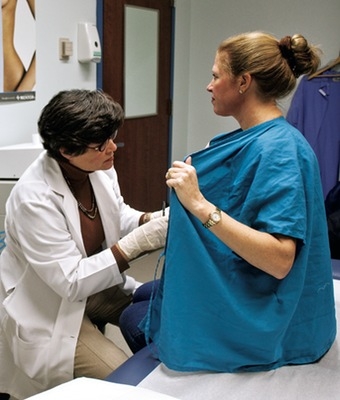
A plastic surgeon can reconstruct a breast using implants, a patient’s own tissue, or a combination. Tissue-flap reconstruction involves moving a section of a patient’s skin, fat, and sometimes muscle from the stomach, upper back, or buttocks to the chest area to create a new breast. The procedure usually results in a softer, more natural breast than an implant alone, but the operation and recovery take longer because the surgery is more complicated.
Many patients get to choose the type of reconstruction they want; for others, the choice is dictated by the person’s size or the type of treatment they need. A patient undergoing radiation, for instance, can have complications from implants.
Teal was a good candidate for implant reconstruction, which involves expanding the skin and replacing breast tissue with silicone gel or saline-filled sacs. She’s thin and didn’t have enough extra tissue in her back or abdomen to be considered for a flap reconstruction. And she was comfortable with the risks: Implants can get infected and harden, which means they have to be removed. They have a 10-to-15-year average life span, so patients can expect additional surgery. She decided on silicone implants instead of saline, she says, because the gel inside feels more like a real breast and is less likely to ripple. Silicone implants were banned in the early 1990s because of concerns about leaks and a possible link to autoimmune disorders and other illnesses. Although research is ongoing, they are now considered safe. Teal has seen them used in many of her patients.
Teal calls plastic surgeon Joanne Lenert “the beautifier.” They’ve worked together in operating rooms for nearly a decade. Dr. Lenert is the one patients count on for a good cosmetic result. Some tell her they want their new breasts to look better than their old ones, perkier and rounder.
Lenert wasn’t shocked when Teal told her she was having prophylactic surgery. She saw her colleague surrounded by cancer patients day in and day out. She could remember three patients she and Teal had operated on together when they were starting out at GW. They were all young women with cancer who’d had mastectomies on one side and left the other untouched. All three later developed cancer in the other breast. Teal told Lenert, “I wish we’d offered to do prophylactic mastectomies.”
Every Monday, Teal meets with radiologists, oncologists, pathologists, genetic counselors, and social workers for something called “tumor board.” They sit at a conference table and discuss all the patients who have been diagnosed with breast cancer that week, usually six to ten people. They look at films and pathology reports, make treatment recommendations, and talk about whether a patient needs extra support. The idea is to get everybody’s input and come to a consensus on the best treatments.
When it came time to discuss her mother’s case at tumor board, Teal hardly said a word. There was no question about what needed to be done: eight cycles of chemotherapy followed by radiation and then Arimidex, an anti-estrogen drug prescribed to postmenopausal women. While McSwain presented the pathology, an oncologist gave Teal a look from across the room, as if to say she understood what she was going through.
The oncologist, Rebecca Kaltman, had lost her own mother to breast cancer in 1998. She was a third-year medical student when her mother was diagnosed with HER2-positive breast cancer, an aggressive form of the disease. At the time, doctors didn’t have a targeted therapy for HER2-positive patients. There was buzz about a drug called Herceptin, which was used to treat metastatic breast cancer, but it wasn’t yet available to patients like Kaltman’s mother. Kaltman called the drug manufacturer from a pay phone at the campus library in the hopes of getting her mother signed up for a clinical trial, but she was unsuccessful. Her mother died 14 months later.
“You know, Becca, I’m doing prophylactics,” Teal said after the meeting. She hadn’t told everybody yet.
Kaltman, 37, was going a different route—staggering MRIs and mammograms every six months, limiting alcohol, exercising and watching her diet. She wasn’t considering surgery. She’d already had a scare and spent an anxious few days waiting for biopsy results, which her husband called the worst weekend of his life, but the close surveillance was reassuring to her. She didn’t mind going into an MRI machine if it meant diagnosing a cancer early. She was treating patients now who had the same type of cancer her mother had, and they were surviving and doing well. But she understood Teal’s point of view: She knew there were high-risk patients who didn’t want to live with all the screening.
“You’re going to help a lot of women struggling with this decision,” Kaltman told Teal.
Teal was happy to hear that. She’d once had a patient who’d watched her mother battle both breast and ovarian cancer; the patient told Teal she was nervous about bringing up prophylactic surgery. Those were the women Teal hoped to reach by sharing her story, the ones who were afraid to talk about it.
Next: “All I want is ten more years.”
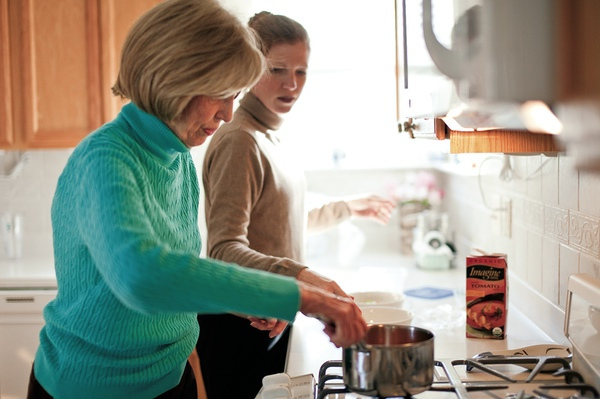
After Teal’s surgery in January, her mother, Nancy—who’d just finished chemotherapy a few months earlier—came to help take care of her. Photograph by Chris Gavin Jones
Teal brought her mother home to her house in Alexandria to recover. They were alone one morning when her mother said, “I know I’m going to die from breast cancer. All I want is ten more years.”
I think we can give you that, Teal thought. I hope we can.
The first time her mother had breast cancer, she’d never given much thought to whether it might affect her daughters. She’d done hormone-replacement therapy after menopause, and the treatment can increase breast-cancer risk, so she had attributed her diagnosis to that. Now that she had cancer again, she wondered if Christy was right: Maybe this was genetic.
There weren’t many women in Nancy Brown’s family, so it was hard to trace any history of breast cancer, but one of her aunts had died in her fifties, and she had never really known what killed her. After her surgery, Nancy called her cousin to ask and found out it was breast cancer.
The genetics of breast cancer is complicated. Both men and women have BRCA1 and BRCA2 genes, which are known to suppress tumor growth. Mutations in those two genes lead to an increased risk of cancer. Female mutation carriers have a 60-to-80-percent chance of developing breast cancer and a 10-to-45-percent risk of developing ovarian cancer. Some decide to have prophylactic surgery, removing their breasts, ovaries, or both.
Some patients don’t want to know if they carry a genetic abnormality or if their relatives do, because they’d rather live without the worry. Others ask for the testing so that if they’re positive—meaning they have mutations in the BRCA genes—they can do something about it. Preventive surgery isn’t the only option; some patients with a strong family history consider taking tamoxifen or raloxifene, which can cut their breast-cancer risk in half. A recent study found that another drug, Aromasin, currently used to treat the disease, can reduce the risk for postmenopausal women by 65 percent.
Teal assumed her mother would test negative because most women who are BRCA-positive develop cancer before they hit menopause. But a negative result doesn’t mean a cancer isn’t hereditary, because BRCA mutations don’t account for all hereditary breast cancers. Five to ten percent of breast cancers run in families, and there are other cancer-predisposing mutations that researchers haven’t yet identified.
When Teal took a sample of her mother’s saliva and had it sent to a laboratory for genetic testing, she wasn’t sure what she wanted the result to be. She’d learned over the years that patients testing BRCA-negative—a good result meaning no mutation of the gene—fell into an area of uncertainty. Some insurance companies were less likely to cover screening procedures, including MRIs, if a patient didn’t have a genetic mutation. Her sister, Marci, who has never considered prophylactics, needed a letter from her doctor explaining why she needed MRIs every year. Teal’s husband’s military health plan, Tricare, agreed to pay for her prophylactic mastectomy—the company was billed more than $80,000—but she’d heard of other insurance companies that didn’t always cover preventive breast surgery.
For Teal, the possibility that her mother might get a negative BRCA result wasn’t going to change anything. If her mother tested positive, she and her siblings would know they had a 50/50 chance of inheriting the BRCA mutation and a more definitive answer about their risk. If Teal’s mother was positive and she herself tested negative, she would know she hadn’t inherited the harmful mutation that had caused her mother’s cancers and she would have canceled the surgery. If her mother was positive and she too was positive, surgery would go on as planned and nobody would question why she was doing it. There’s nothing unusual about prophylactics for a BRCA-positive patient.
A colleague put her mother’s test results on Teal’s desk about four weeks after she sent them off: negative.
“Are you sure you need to do this?” her mother asked. She’d never told her daughter not to have the mastectomies, but she didn’t like the idea of unnecessary surgery.
“Yes,” Teal said. “I’m sure.”
Her mother didn’t have a BRCA mutation, but as far as Teal was concerned, she probably had a different one.
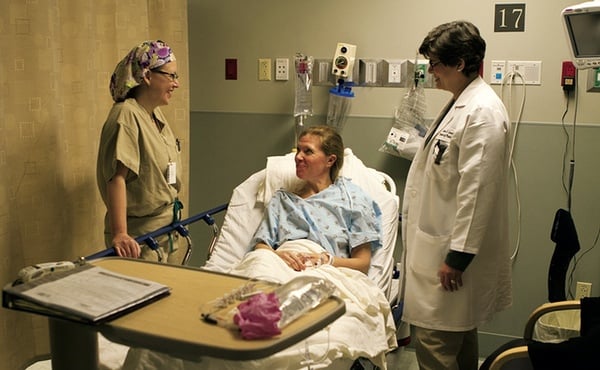
Christy Teal talks with colleagues Dr. Anita McSwain and Dr. Joanne Lenert, who together performed her first surgery in January. Photograph by Brandon Bray
Any patient at GW Hospital can pay extra to stay in the large private room on the fifth floor, where Teal stayed, but physicians and their family members get priority when the room isn’t being used. It’s not the hospital’s sole VIP suite—there’s also a room on the cardiology floor, where former Vice President Dick Cheney stayed during his visits. The best thing about VIP rooms, Teal says, is all the windows.
On January 11, six months after seeing her mother’s MRI, Teal was settled into her hospital room, the same one where she’d visited her mom. It had taken three hours for McSwain to remove Teal’s breasts, leaving her nipples intact, and another three for Lenert to insert tissue expanders, which are placed under the muscle and designed to stretch the skin and muscle gradually to make room for the final implants.
That night, Teal was up every hour. Whenever she moved, she felt as if she’d pulled a muscle. It took a while to get the discomfort under control. The drug fentanyl helped, but she was dizzy and wanted the catheter out.
What have I done? she thought.
Still, she felt blessed that she wasn’t there because she had cancer and that she didn’t have to start thinking about radiation or chemotherapy, as some of her patients did. She wondered how they had the strength. The next day, Teal sat in a chair reading work e-mails and called a patient who’d just learned she had metastatic breast cancer.
When she called to talk to her kids, Ashley, the eldest, got on the phone and cried. The girl wasn’t worried that her mom was sick—she just wanted her to come home. McSwain stopped by for a post-op visit to see how Teal was feeling and to check her surgical drains, long tubes inserted into the breast that clear out excess fluid after surgery. Most patients have them for up to two weeks.
“I know how hard this was for you,” Teal said. It was one thing to operate on a colleague, but she and McSwain were friends. “I just want to thank you. I’m convinced you’ve saved my life.”
Teal’s friend Laurie Turney flew in from Colorado after the surgery. Teal had helped Turney recover after her bilateral mastectomies in 2007. She’d had the operation in Washington and spent two weeks at Teal’s house afterward. Teal set up a bedroom for Turney and helped her with her surgical drains. When Turney was craving macaroni and cheese, Teal made it for her. They lay in Teal’s bed reading People magazine.
Turney wanted to be there for Teal the way Teal had been there for her. Turney had leaned on her friend since her first diagnosis in 1997. Her gynecologist was showing her how to do a self-exam when he found a pea-size lump. The diagnosis was infiltrating ductal carcinoma, the most common type of breast cancer, which starts in a milk duct and invades the breast tissue. Her cancer was Stage II because it had spread to one of her lymph nodes. She’d lost her father to breast cancer when she was 22. His doctors were shocked that a 38-year-old man had breast cancer, and within five years the disease had spread to his brain and bones.
I’m going to die, Turney thought when she was alone in bed. I’m going to die like my dad.
She called her best friend.
“I’ll be there soon,” Teal told her. “And you’re not going to die from this.” She got on a plane the next day.
Turney had a lumpectomy followed by chemotherapy and radiation. She didn’t want to see hair on her pillow, so she made an appointment with her hairdresser, brought a bottle of wine and a friend, and had her head shaved. She slept for a few days after every treatment; acupuncture helped ease the nausea.
When Turney finished chemo, doctors put her on tamoxifen for five years. She took a blood test to see if she carried a BRCA mutation, and it came back negative. At that time, there was little discussion about unidentified genetic mutations. Both she and Teal breathed a sigh of relief.
Five years passed, and Turney was cancer-free. One day in 2002, she got a call from an oncologist who’d taken care of her father. The doctor, Charles Vogel, was a pioneer in treating male breast cancers. He’d stayed in touch with her family.
“I want you to consider something,” she remembers him saying. “I’m seeing more and more women come back at six and seven years with a recurrence. Young women. And I don’t want to see you go through this. I know it sounds radical, but I want you to consider bilateral mastectomies and having your ovaries out.”
Turney had just gotten engaged. She felt good. She wanted to have children and be able to nurse them. Now is not the time, she said.
A few years later, she had breast cancer again.
“What did I do wrong? How could this happen?” she asked Teal. The chemo was worse this time: She walked around with a metallic taste in her mouth. Her hands were so sore that it hurt to pick up a napkin.
“You did nothing wrong,” Teal said. “This has nothing to do with you or anything you did or didn’t do. This is a hereditary thing: You have a gene we don’t know about.”
Next: Exhaustion sets in
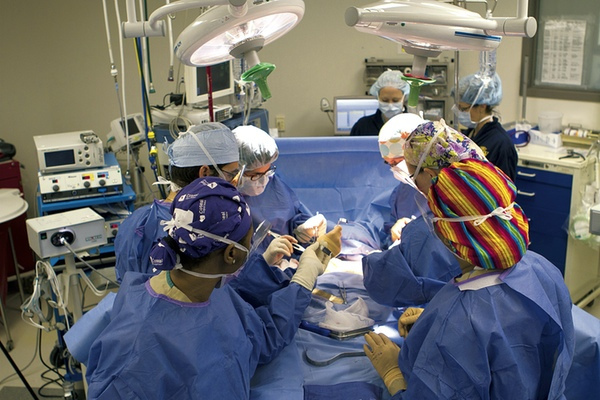
The reconstruction process took more than four months. Photograph by Brandon Bray
When it was Teal’s turn to be the patient, Turney lifted the coffeepot for her and pulled dishes from high cabinets. But it was mostly naps Teal needed. She didn’t want help getting her shirt over her head or getting into the shower. She wanted to do things herself, the same way her mom had. Back in 2010, Teal couldn’t believe it when she caught her mother digging in the garden ten days after her mastectomies.
“What do you think you’re doing?” Teal asked.
“I can’t stand looking at your weeds anymore,” she said.
Now Teal understood. She didn’t want to feel helpless. She told herself she’d use the time off from work to edit a research paper she’d written. She e-mailed her plastic surgeon to see when she’d be able to jog again.
But she was more exhausted than she expected. She’d heard patients talk about how tired they were for the first few weeks, and now she was feeling it. She’d take a small dose of Valium at night to help with the muscles spasms, fall asleep by 10, get up at 7:30, and still not have any energy. She was usually a stomach sleeper but didn’t want to risk hurting her healing nipples, so she tried to sleep on her back. Every time she rolled onto her side, she woke herself up.
There’s no way I’ll be running in a month, she thought. How will I be ready to go back to work in four weeks?
Her chest was numb and her body so tight that she felt as if she had on a girdle. Patients had complained to her about the tightness, a result of the tissue expanders tucked behind the muscle.
They’re not kidding, Teal thought.
Her kids had to hug her more gently than usual. Ellie would ask if her mom’s “boo-boos” were okay. Nick was fascinated by the tubes coming out from under his mother’s shirt. “Can I see the drains?” he’d ask.
Teal had always told patients that getting the surgical drains out was no big deal. When her mother drove her to GW to get hers out, Teal was standing by the elevator when she said, “I really hope this doesn’t hurt.”
At her first physical-therapy session, Teal is flat on her back. “Breathe,” her therapist Bretta Fabian tells her. “Breathe.”
Gentle massage on connective tissue can make some patients lightheaded. Teal has always gotten nauseated easily, another reason she had to get out of general surgery. So much of general surgery now is laparoscopic, and Teal would get motion sickness from using the scopes while looking at a television screen.
Teal sends patients to Bretta Fabian for physical therapy after breast surgery to work on range of motion and releasing scar tissue. The sessions are especially helpful for patients who have had axillary lymph-node dissections in the armpit, which Teal’s mother had. “Push this hand towards the window behind you,” Bretta tells her.
Teal says, “Are you sure?” Bretta already used relaxation techniques on her shoulders, which made the muscles hurt, and reaching for the window seems impossible. “I feel so bad for patients who don’t have good arm mobility. My mobility is pretty good,” Teal says just before letting out a small scream.
Teal worried before surgery that once she had a mastectomy, she’d be more inclined to recommend the procedure to patients. She didn’t want that to happen—she knew what she’d done wasn’t right for everyone. Her colleague Robert Siegel wasn’t concerned—Christy Teal was too good to let a personal choice change the way she practiced medicine—but Teal was afraid she’d come across as biased, even by accident.
By week three, she knew that wouldn’t be happening: Physically, the surgery was a big deal. From a surgeon’s standpoint, a double mastectomy was an operation like any other. From a patient’s perspective, it was harder than she’d ever imagined.
At the six-week mark, Teal started feeling like herself again. She went on short runs and took her kids on bike rides. The tightness in her arms felt better, and she stopped noticing every little ache. A patient who’d had prophylactic surgery told Teal she could no longer do push-ups.
Good, Teal thought. I hate push-ups.
She was so focused in the operating room that she forgot she’d had surgery. She’d put on scrubs, turn on classic rock—or Norah Jones if it was an especially difficult surgery—and the pain went away.
She hadn’t planned on telling all her patients what she’d done, only those she knew were having a similar surgery, but some started asking how her vacation was.
“Good for you,” one woman said when she found out. She’d had breast cancer that didn’t show up on a mammogram.
A few patients told Teal she was brave for having surgery. She kept thinking about her patients—and about Turney—who didn’t get to choose when they went to the hospital and didn’t get to go back to work a month later. Those were the people who inspired her: the patients fighting breast cancer.
Some of Teal’s patients came out of surgery wondering what the pathology was going to show, how quickly their cancer was progressing, how much time they had left with their children. She came out feeling as if she was never going to get breast cancer. She didn’t feel brave; she felt lucky.
Next: Implants will take some getting used to
When Teal went to see Lenert for her first tissue expansion in early March—part of the process of constructing her new breasts—her left nipple was starting to hurt. She thought she was getting feeling back but realized later it was muscle pain. Lenert says most patients who have nipple-sparing mastectomies don’t regain feeling in their nipples.
“I’m going to shut my eyes—I don’t think I need to watch,” Teal said as she lay on an examination table in Lenert’s sixth-floor office. Lenert used a magnet to find the ports she’d placed under Teal’s skin during surgery, then injected each tissue expander with 80 milliliters of sterile saline.
“It feels like getting your blood drawn,” she told Teal. “Sometimes when the needle goes through, it makes the muscle jump, but it doesn’t hurt much.”
Each time a patient comes in for a tissue expansion, Lenert puts in more saline to make her breasts a little bigger. When the skin has stretched to a size the patient likes—in Teal’s case, a “B”—Lenert takes out the expanders and uses the original surgical incision to insert silicone implants. Some patients require two expansions; for others, it might take six. The final procedure is done in the operating room, four or five months after the initial surgery.
“D cup?” Lenert joked, as she pumped in the saline.
Teal laughed: “Dave will thank you.”
This was a part of breast reconstruction Teal had never seen, and she wasn’t sure what to expect. She held onto a nurse’s hand.
“Not too bad, right?” Lenert asked.
“Not bad at all. I didn’t even feel a thing. It’s the anticipation, as always.”
She left the room to get dressed and checked a mirror on her way back in.
“These are big!” she said, laughing. She had one or two more tissue expansions to go and realized she really would have bigger breasts than the ones she started with. The implants would take some getting used to.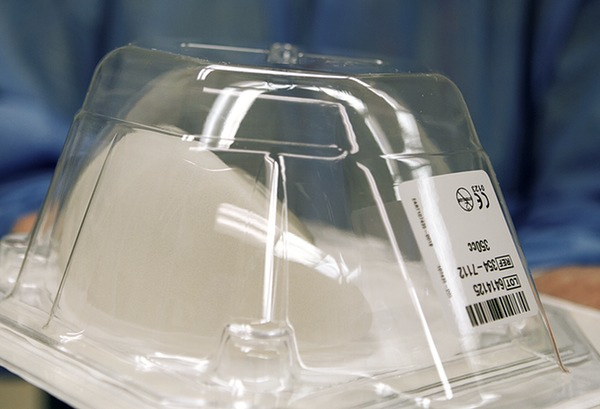
Teal chose to have a double mastectomy with reconstruction. Lenert used tissue expanders to stretch Teal’s skin and muscle to make room for silicone implants. Photograph by Brandon Bray
The goodie bags for Ashley’s eighth-birthday party are almost ready. They’re pink, like the tiny breast-cancer-awareness ribbon on Teal’s sunglasses and the water bottle she always has with her. Ashley wanted only girls at her party this year, so Teal offered to paint their nails. Her daughter went online and picked out glow-in-the-dark nail polish.
Teal’s mother is in town for her granddaughter’s birthday and brought presents for all of the grandkids. She got Nick a new Nerf gun. “Don’t shoot it in people’s faces—or it’s gone,” Teal tells him. His twin sister, Ellie, got a Swimsuit Barbie and wants to dress just like her.
Ellie found 50 cents under her pillow after she swallowed a front tooth. Somehow, Teal told her, the Tooth Fairy hears about these things. Teal was glad the tooth was out: She may be a good surgeon, but she wasn’t about to pull her daughter’s tooth.
Teal has thought about whether she’d have had the mastectomy if she didn’t have children, if it were just she and Dave, but she can’t come up with an answer. Her happiest moments are watching the kids at the playground or dancing in the living room. She wanted to do the surgery when they were still young, before Ashley was old enough to start thinking about her own breasts.
She couldn’t imagine how tough it had to be on other kids to watch a parent go through chemotherapy. At this age, all that mattered to Ashley was that her mom would be home from work while she was recovering and get to meet her at the bus stop.
It’s been about three months since Teal’s mom finished chemo, and her hair is coming back. She has about an inch, and it’s gray, which she’s having trouble getting used to. She hasn’t seen her real hair color in years.
“You guys have to feel this,” Teal tells the kids when her mom takes her wig off. “It’s the softest hair when it comes in after chemo. I always make my patients let me feel their heads.”
The kids ask if they can wear Grandma’s wig, and Teal takes some photos. Ellie thinks she looks like a rock star.
“Did you get a haircut?” Nick asks.
“I got a haircut,” Teal’s mom says. “Sort of.”
Next: “The next day will be better, I promise.”
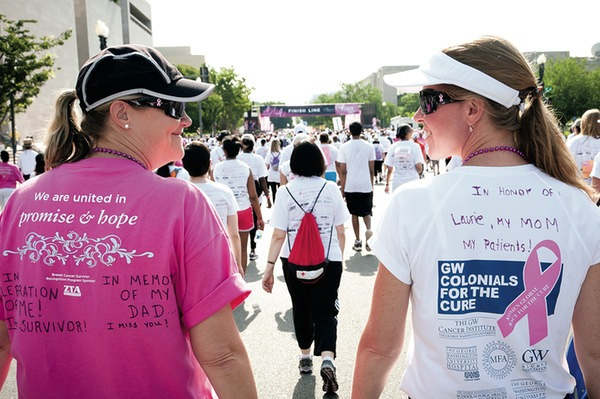
Teal (right) and her best friend, Laurie Turney—who has been cancer-free for five years—were eager to be a part of this year’s Race for the Cure. Photograph by Erik Uecke
The patient sitting in Teal’s office wants to know every detail. She’s a week away from having a prophylactic bilateral nipple-sparing mastectomy, the same surgery Teal had. This time, Teal will be operating. The woman’s mother and grandmother died of breast cancer, and a few months ago she tested positive for a BRCA2 mutation, putting her at increased risk.
The patient, who’s in her sixties, has lots of questions: What will the incision look like? How long do the drains stay in? What kind of bras work best after surgery?
“There’s one I really liked, and I’m still sleeping in it,” Teal tells her. “It’s the Amoena surgery camisole. It’s got a zipper in the front, which is really nice, and there’s a little pouch for your drains.” She got the camisole from her mom, who’d used it when she was recovering. “Nordstrom at Pentagon City has a whole mastectomy section. That’s where I went with my mother.”
Teal was surprised at how much was out there for women who’d had cancer surgery. When she went to Victoria’s Secret and told the salesclerk she was a size A but was going to end up a B after reconstruction, the woman didn’t bat at eye. They must hear that a lot, Teal thought. She’d always been able to give her mastectomy patients advice, but that was different. Now she could tell a woman how it felt to look in the mirror after a shower and see a part of herself she couldn’t feel.
“You will continue to have good days and bad ones,” she wrote in a guide for her patients about what to expect. “When it is a bad day, do not push it. Lie in bed with your computer or a magazine or a good movie and just take it easy. The next day will be better, I promise.”
Teal’s husband had taken photos of her every few days so she could show patients what the recovery process was like.
“Here’s week one, post-op,” Teal tells the patient in her office. “See? This nipple is having a little trouble.” She had a complication after surgery called mastectomy flap necrosis—the tissue around the nipple blistered and became discolored because of insufficient blood supply. This is not uncommon in a nipple-sparing procedure, and she wants patients to know it can happen because it delays the healing process.
“So you go in, you come out, and you wake up how long after surgery?” the patient asks.
“I don’t remember the recovery room at all, though I was told by the nurse that I was very lucid,” Teal says. “Don’t have any visitors Tuesday night. You’ll want your husband there, just to sit with you, but you’re not really going to want anybody else.”
The patient started seeing Teal a few months ago after going to another breast surgeon for years. They clicked right away: The woman checked in to see how Teal’s mother was doing and sent her photos of her new puppy.
“It’s such a blessing that I found you,” she says to Teal. “I’m so happy you’re okay.”
“I’m glad it’s behind me,” Teal says. “I’m glad I did this. I think about what I watched my mom go through and . . . .”
“You don’t want to go through it,” the woman says. “I know. God, I know.”
Teal’s shirt reads: IN HONOR OF LAURIE, MY MOM, MY PATIENTS. Her white visor has one word on it: hope.
“Isn’t it so weird that just last year we were talking about how lucky my mother was?” she says. She’s on mile two of the Race for the Cure, walking alongside her mom, Turney, and the colleague who performed her operation, Anita McSwain. Teal has already bumped into a patient.
Things were different when she did this race a year ago. Her mother had faced cancer once, not twice. Teal herself still had her breasts. Now she has silicone implants, and as good as they feel, there are moments that remind her they aren’t real, such as when she pushes a door open or turns her arms a certain way. But she’s happy with how they turned out: Turney keeps telling her how great her “new girls” look, the kind of thing only a best friend will say. A week after her final surgery, Teal put on a two-piece bathing suit and took her kids to the pool.
Both Turney and Teal’s mom are wearing pink breast-cancer-survivor shirts, along with thousands of others who’ve gathered on the Mall. Later, someone hands them survivor medals. “You deserve those,” Teal says.
As they near the end of the route, she links arms with Turney and the two of them do a little dance before walking across the finish line.
This article appears in the July 2011 issue of The Washingtonian.

















